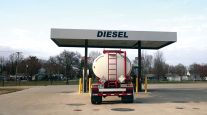Lower Fuel Prices Have Broad Impact
“We charge a straight hourly rate and we don’t adjust that for fuel prices,” said Becky Esker, owner of Heck’s Transfer, a Cedar Rapids, Iowa, moving company. “Right now, the cost savings is wonderful.”
As the price of crude oil has plummeted from $100 a barrel to just $30 a barrel because of an oversupply and a slacking demand worldwide, the average price of unleaded regular gasoline dropped to $1.91 a gallon and diesel fuel dipped to an average $2.11 a gallon on Jan. 18, according to the U.S. Energy Information Administration.
For the Cedar Rapids Community School District, which operates a fleet of school buses averaging 5 or 6 mpg, lower diesel fuel prices is welcome news.
“Any cost savings is a huge benefit, especially at this time of year when we’re having to start buses in the mornings with temperatures in the teens,” said Denny Schreckengast, district transportation manager. “We start and run them for 10 or 15 minutes earlier than normal so they are a little bit warmer and act a little better mechanically.”
Diesel prices have dropped about 13 to 16 cents a gallon since December, he said, depending on the grade of fuel. “And at a million miles (driven) per year, any reduction in price is really helpful,” he said.
On a much smaller scale, delivery drivers for Jimmy Johns sandwich shop are seeing a direct benefit.
“The drivers are making more money because they’re responsible for fueling their own cars,” said Nick Warson, area manager for the chain. “That’s more money in their pocket and less that they have to put in their cars.”
Warson said, though, the company has not seen any corresponding savings from wholesale food suppliers as fuel prices have dipped.
“The cost of delivery may be lower, but the cost of the product has gone up,” he said.
Likewise, the consequences of lower fuel prices may not be so obvious in other cases.
For Rick Brandon of Marengo, it’s bittersweet.
“I have mixed feelings, because I am a gas hauler for Casey’s,” Brandon said while filling up his Ford F-150. “It’s good people are buying more, but I got a lot of Casey’s stock. The price of gas is bringing the stock down. I am looking to retire soon, and I can’t do that until that stock goes up.”
Semi-trailer truck driver Patrick Miller of Dennis L Frazier Trucking in Kahoka, Mo., tells a similar story.
The cheaper diesel he fills his 2007 Kenworth truck with isn’t filling his company’s pockets.
“It’s cutting into our profit margin,” Miller said. “We actually made more money when fuel is higher.”
When fuel prices are high, customers pay a fuel surcharge to the company. But now customers are paying less for trucking companies to move products because of the lower diesel price. Miller said the company’s rates across the country are around $1.50 a mile — a price he hasn’t seen since the mid 1990s when gas was 79 cents a gallon.
For organizations with large fleets of vehicles, the lower prices can be a big factor in lowering bills by thousands of dollars.
The city of Cedar Rapids, which has 685 vehicles and 525 power-operated equipment such as skid loaders and lawn tractors, experienced a fairly significant reduction in fuel costs from July through December when compared with the same six months in 2014.
City spokeswoman Maria Johnson said the amount the city spends on fuel each year is a combination of prices and vehicle activity, such as snow plow use or police and fire responses. Johnson noted that the city has had fewer snowfalls requiring snowplows to roll in this period than in a typical year.
The city spent $507,253 on diesel fuel from July through December, compared with $924,580 from July through December 2014. For unleaded gasoline, the city paid $297,864 from July through December, down from $514,907 the same period the year before.
While low gas prices are generally good for consumers, some negative environmental impacts exist.
While cars are more fuel efficient, it’s the big ones like sport utility vehicles and crossovers that led the pack in record auto sales last year.
“A downside is there’s an uptick in SUV sales, so for people concerned about climate change, that’s not good news,” said Tyler Priest, associate professor of geography who is an oil historian and teaches energy policy at University of Iowa. “It’s obvious people are going to drive more. If we use history as any guidelines, low oil prices encourage more consumption, which means more emissions.”
B.A. Morelli of The Gazette contributed to this report.




